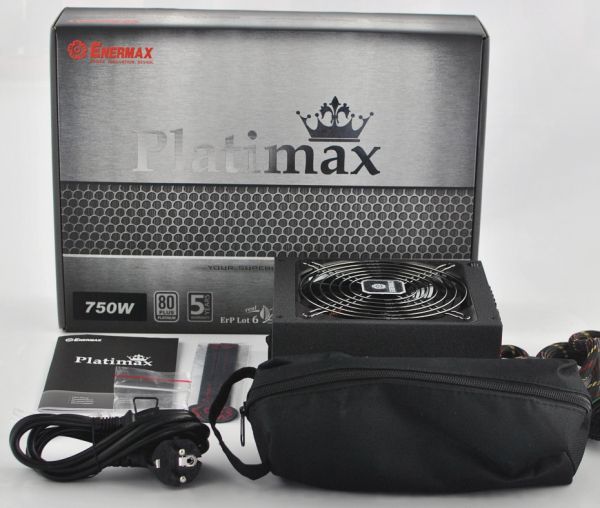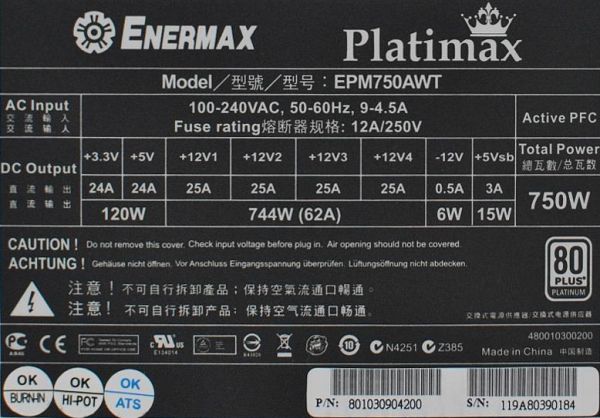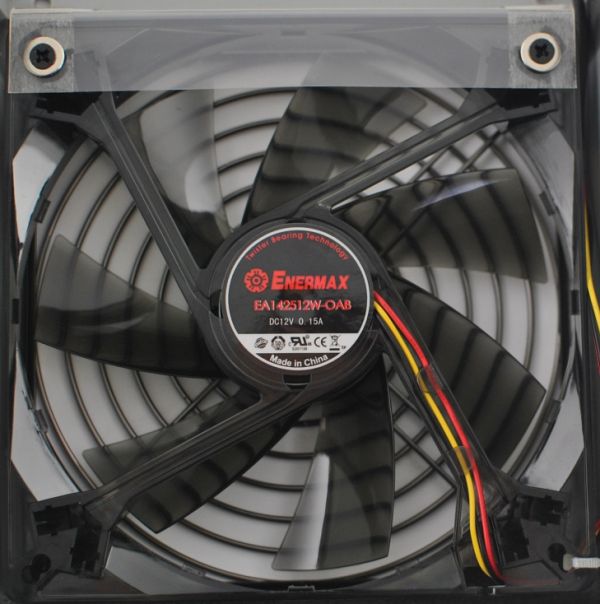Enermax Platimax 750W - 80 Plus Platinum Arrives
by Martin Kaffei on February 10, 2012 6:00 PM EST- Posted in
- Cases/Cooling/PSUs
- PSUs
- 80Plus
- 750W
- Enermax
- 80Plus Platinum
Package Contents, Power Rating, and Fan
The contents in the package are very generous. Besides the so-called "CordGuard" that secures the power cord, users get some Enermax cable ties, an Enermax sticker, a user manual, and the modular cables in a separate bag. Features of the product include the 80 Plus Platinum certificate, a 5 year warranty, the improved resonant converter, and other technical refinements; we'll cover those in more detail later. There is also a "HeatGuard", which is nothing more than a temperature monitor that will continue to cool the PSU after you shut off the PC/PSU (if necessary).
According to the label the PSU has four +12V outputs rated at 25A each, which together can provide almost the entire power output (744W). Both +3.3V and +5V are specified at 24A. Those outputs can provide up to 120W, which is slightly lower than the values from most power supplies in this performance class but typically more than sufficient for modern PCs. The +5VSB at 3A is also relatively strong.
Enermax relies on its own high-quality Twister fan for cooling, with the model number EA142512W-OAB. This one has seven transparent fan blades and is based on Enermax's "Twister Bearing". The fan is rated at just 0.15A current, which is rather moderate. The fan runs at low speeds ranging from 300 to 1000RPM. Well, at least that applies to the fan in Platimax models below 1000W. Thanks to some patents, the fan has a 13.9cm diameter, but it's basically a 140mm fan.













47 Comments
View All Comments
ssj3gohan - Sunday, February 12, 2012 - link
In this sentence:"(...) This compensates for the slightly higher losses during turn-on (which is no problem with a low resistance between drain and source). (...)"
you imply that the drain-source resistance has something to do with the switching losses. This is not the case! Let me explain: there are two types of losses associated with power transistors: on-state losses and switching losses. On-state losses are incurred when the transistor is fully on and conducting current; it's simply the drain-source on-state resistance (R(DS, on)) times current squared. Then there's losses associated with the transition from off to on, or from on to off. At this moment, the transistor doesn't instantaneously turn on or off, but enters its linear region. At this time, both high voltage and current exist simultaneously over and through the device, which means P=I*U=high losses. You can't fix this with lower on-state resistance because the transistor is not in its on-state, it is in some state in between. This transient period is only very short (tens of nanoseconds) but if you switch really fast, e.g. 200kHz+ which is what happens in some power supplies, the losses add up quickly. The only way to combat these losses is:
- Making either I, or U, or both zero at switching time (zero current, zero voltage switching [ZVS, ZCS])
- Making the transient period as short as possible (which in practice means reducing gate charge or if possible using better drivers)
That last bit is pretty much a no-go for modern supplies because it causes noise spikes, hence the advent of ZCS and ZVS.
Martin Kaffei - Sunday, February 12, 2012 - link
I know. This might be a translation failure.The previous sentence is already about turn-on ("switching"), so this one was about the next phase.
In this case I meant saturation (no sure if this is the correct word in English).
kenyee - Sunday, February 12, 2012 - link
I.e., is it small enough to fit in actual HTPC cases?86% efficiency at 10% load makes it enticing... :-)
Lithium466 - Monday, February 13, 2012 - link
It seems that the 5Vsb rail is not protected, and that overloading it (with more than 4A) will permanently destroy the power supply...Have you tried it ? Is is true ?
ShieTar - Monday, February 13, 2012 - link
Apparently 20% are specified to be 20% on each rail, for each voltage, (see the qualification test report here: http://www.plugloadsolutions.com/psu_reports/ENERM... ).To me, this seems to be a bit less than realistic. In normal day usage, I would expect the 12V rail to be the one that really changes between idle and load cases, with the other voltages remaining at a relatively constant, and rather low, load.
Would it be possible to test efficiency at a few realistic load cases on top of the ones used by the specification? This would be really interesting to see.
86waterpumper - Monday, February 13, 2012 - link
I agree that alot here run higher end gaming rigs and may use 750 watts of power or even more. I also say that alot here are more likely to have htpcs, servers, and secondary systems somewhere in their house they themselves have built. Then you have the times when a friend or family member wants you to build a system for them to do light tasks. It doesn't always make sense to use a pico type supply for these and there is a gap between say 200 watts and 400/450 watt psus. For all these reasons it is past due time that we get some more efficient lower watt supplies. Right now my main system is a 2500k using the onboard hd3000 video I can play games fine since I have dual older 4:3 monitors still. I currently am using a x-400 seasonic and it's great but I really wish there had been a x-200, 250 or 300 instead.There will be a need for high end video cards for those that want to run huge monitors, but as onboard graphics get better and better we will see a shift where people who don't game all the time or want to blow 500 bucks on a video card are content with using onboard. It would be like if chevrolet decided to ONLY make the camaro and corvette fuel efficient and did not care about the compact cars it just does not make sense. I think psu manufacturers are missing the boat in a way but I'm also sure they are afraid that people will not pay a premium for a psu unless it has big watt numbers...
Iketh - Monday, February 13, 2012 - link
My thoughts exactly. I'm sick of using 400w power supplies to power 50-100w. I've even thought of the possibility of tapping into the wires or finding splitters for every plug so I can run 2-3 systems off one power supply.